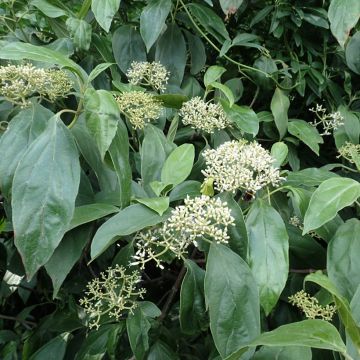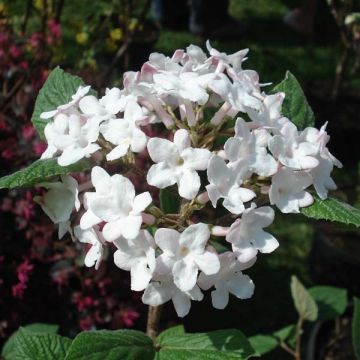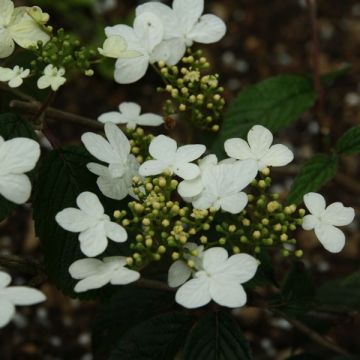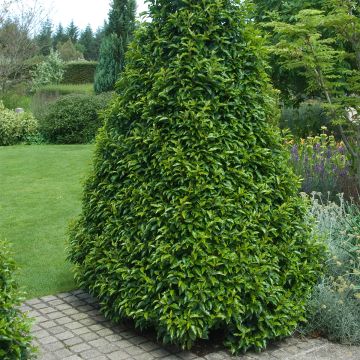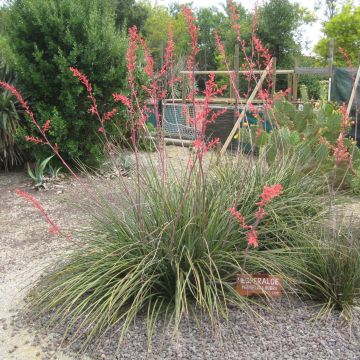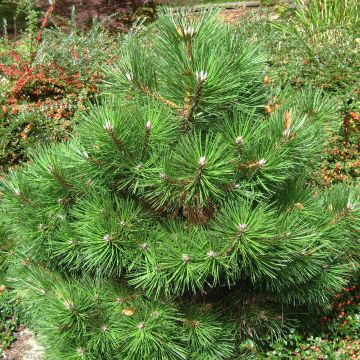

Viburnum rhytidophyllum


Viburnum rhytidophyllum
Viburnum rhytidophyllum
Viburnum rhytidophyllum
Wrinkled viburnum
Good, not very pretty as a plant but it has become huge and since I planted a flower bed in front of it, it stops the North, Northwest winds and protects the other bushes. However, it still hasn't flowered white (?) Its leaves are nicely shiny dark green and it looks nice.
Ycel(lesjardins), 21/10/2024
This item cannot be shipped to the selected country
Delivery charge from €5.90
More information
Schedule delivery date,
and select date in basket
This plant carries a 24 months recovery warranty
More information
We guarantee the quality of our plants for a full growing cycle, and will replace at our expense any plant that fails to recover under normal climatic and planting conditions.
From €5.90 for pickup delivery and €6.90 for home delivery
Express home delivery from €8.90.
Does this plant fit my garden?
Set up your Plantfit profile →
Description
Viburnum rhytidophyllum, also known as the Wrinkled-leaved Viburnum, is a large evergreen bush, named after the uniquely wrinkled appearance of its long oval leaves, which give it its distinctive character. Its large wavy and pendulous dark green and glossy leaves are velvety grey on the underside. They provide a beautiful setting for its spring flowering, which blooms in large flat cream-white corymbs. The fruiting is also quite decorative, in the form of small red then black berries when ripe, with both colours often present on the same plant. Easy to grow in the sun, in ordinary soil, even limestone, but deep and moist. Viburnums are easy-going bushes that integrate well into informal hedges, mixing different species or combining them with other flowering shrubs.
Viburnum rhytidophyllum belongs to the Viburnaceae family, which includes many species of deciduous or evergreen Viburnums, with occasionally fragrant flowering. It originates from central-west China and has been used in European parks and gardens for a long time due to its fast growth, ease of cultivation, and low maintenance requirements. It is a large evergreen shrub, with an imposing and bushy habit, often as wide as it is tall. At maturity, it will reach 3 to 5m (10 to 16ft) in all directions, with rapid growth. The leaves are entire, dark green and glossy on the upper side, fuzzy and dull on the underside, oblong, deeply veined, measuring 15 to 20cm (6 to 8in) long. The flowering takes its time: the acid-green buds appear grouped in flattened and rounded cymes, 20cm (8in) wide, at the ends of the branches, from November onwards. They open gradually in May-June, in small cream-white flowers, sometimes pinkish. This flowering is sometimes fragrant. It is followed by the formation of small ovoid red fruits, turning black when ripe, which are a delight for birds. To obtain a beautiful fruiting, it is recommended to plant several plants.
Viburnum rhytidophyllum is an excellent shrub for informal hedges. It only requires a sunny exposure and fairly deep and not too dry soil to thrive. It also makes a beautiful specimen, planted as a backdrop. For example, plant it with the deciduous Viburnum x bodnantense, with early flowering, the highly colourful Viburnum lantana in autumn, lilacs, Japanese quinces, Chinese almonds, Viburnum davidii, Rosa complicata, Cotoneaster lacteus.
Report an error about the product description
Viburnum rhytidophyllum in pictures
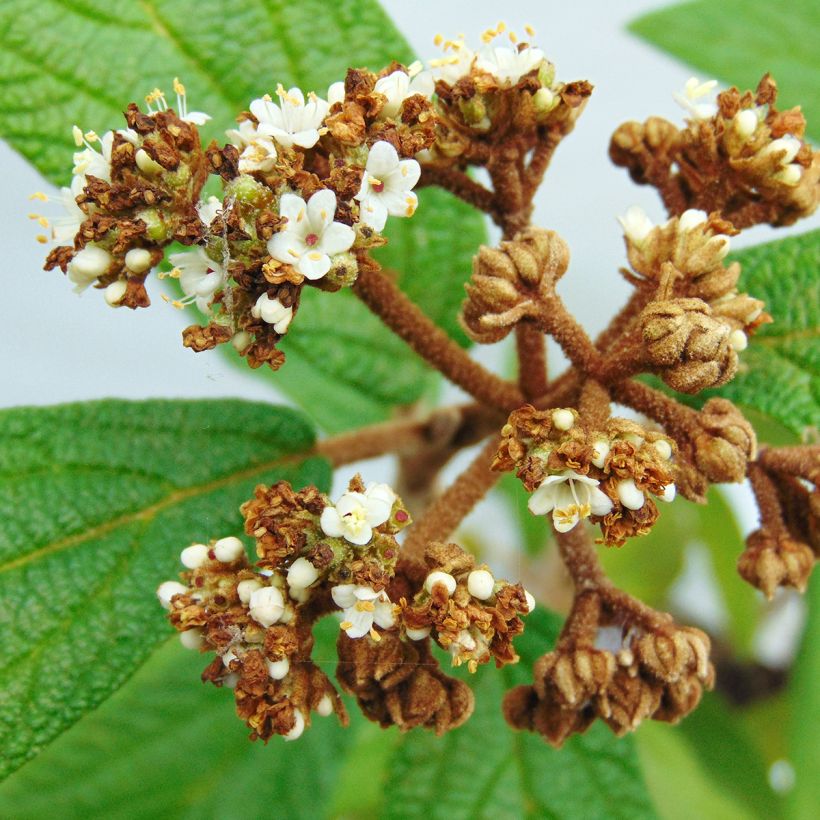







Plant habit
Flowering
Foliage
Botanical data
Viburnum
rhytidophyllum
Caprifoliaceae
Wrinkled viburnum
China
Other Viburnum
Planting and care
It is not demanding on soil type as long as it is deep and moist. It tolerates limestone well. Plant it in regular garden soil, in a sunny or semi-shaded location. This bush is hardy below -20°C (-4°F). It does not need pruning.
Planting period
Intended location
Care
-
, onOrder confirmed
Reply from on Promesse de fleurs
Evergreen shrubs
Haven't found what you were looking for?
Hardiness is the lowest winter temperature a plant can endure without suffering serious damage or even dying. However, hardiness is affected by location (a sheltered area, such as a patio), protection (winter cover) and soil type (hardiness is improved by well-drained soil).

Photo Sharing Terms & Conditions
In order to encourage gardeners to interact and share their experiences, Promesse de fleurs offers various media enabling content to be uploaded onto its Site - in particular via the ‘Photo sharing’ module.
The User agrees to refrain from:
- Posting any content that is illegal, prejudicial, insulting, racist, inciteful to hatred, revisionist, contrary to public decency, that infringes on privacy or on the privacy rights of third parties, in particular the publicity rights of persons and goods, intellectual property rights, or the right to privacy.
- Submitting content on behalf of a third party;
- Impersonate the identity of a third party and/or publish any personal information about a third party;
In general, the User undertakes to refrain from any unethical behaviour.
All Content (in particular text, comments, files, images, photos, videos, creative works, etc.), which may be subject to property or intellectual property rights, image or other private rights, shall remain the property of the User, subject to the limited rights granted by the terms of the licence granted by Promesse de fleurs as stated below. Users are at liberty to publish or not to publish such Content on the Site, notably via the ‘Photo Sharing’ facility, and accept that this Content shall be made public and freely accessible, notably on the Internet.
Users further acknowledge, undertake to have ,and guarantee that they hold all necessary rights and permissions to publish such material on the Site, in particular with regard to the legislation in force pertaining to any privacy, property, intellectual property, image, or contractual rights, or rights of any other nature. By publishing such Content on the Site, Users acknowledge accepting full liability as publishers of the Content within the meaning of the law, and grant Promesse de fleurs, free of charge, an inclusive, worldwide licence for the said Content for the entire duration of its publication, including all reproduction, representation, up/downloading, displaying, performing, transmission, and storage rights.
Users also grant permission for their name to be linked to the Content and accept that this link may not always be made available.
By engaging in posting material, Users consent to their Content becoming automatically accessible on the Internet, in particular on other sites and/or blogs and/or web pages of the Promesse de fleurs site, including in particular social pages and the Promesse de fleurs catalogue.
Users may secure the removal of entrusted content free of charge by issuing a simple request via our contact form.
The flowering period indicated on our website applies to countries and regions located in USDA zone 8 (France, the United Kingdom, Ireland, the Netherlands, etc.)
It will vary according to where you live:
- In zones 9 to 10 (Italy, Spain, Greece, etc.), flowering will occur about 2 to 4 weeks earlier.
- In zones 6 to 7 (Germany, Poland, Slovenia, and lower mountainous regions), flowering will be delayed by 2 to 3 weeks.
- In zone 5 (Central Europe, Scandinavia), blooming will be delayed by 3 to 5 weeks.
In temperate climates, pruning of spring-flowering shrubs (forsythia, spireas, etc.) should be done just after flowering.
Pruning of summer-flowering shrubs (Indian Lilac, Perovskia, etc.) can be done in winter or spring.
In cold regions as well as with frost-sensitive plants, avoid pruning too early when severe frosts may still occur.
The planting period indicated on our website applies to countries and regions located in USDA zone 8 (France, United Kingdom, Ireland, Netherlands).
It will vary according to where you live:
- In Mediterranean zones (Marseille, Madrid, Milan, etc.), autumn and winter are the best planting periods.
- In continental zones (Strasbourg, Munich, Vienna, etc.), delay planting by 2 to 3 weeks in spring and bring it forward by 2 to 4 weeks in autumn.
- In mountainous regions (the Alps, Pyrenees, Carpathians, etc.), it is best to plant in late spring (May-June) or late summer (August-September).
The harvesting period indicated on our website applies to countries and regions in USDA zone 8 (France, England, Ireland, the Netherlands).
In colder areas (Scandinavia, Poland, Austria...) fruit and vegetable harvests are likely to be delayed by 3-4 weeks.
In warmer areas (Italy, Spain, Greece, etc.), harvesting will probably take place earlier, depending on weather conditions.
The sowing periods indicated on our website apply to countries and regions within USDA Zone 8 (France, UK, Ireland, Netherlands).
In colder areas (Scandinavia, Poland, Austria...), delay any outdoor sowing by 3-4 weeks, or sow under glass.
In warmer climes (Italy, Spain, Greece, etc.), bring outdoor sowing forward by a few weeks.





































